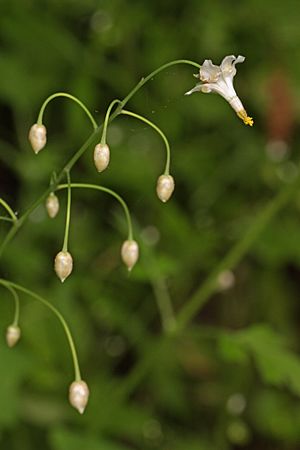White inside-out flower facts for kids
Quick facts for kids White inside-out flower |
|
|---|---|
 |
|
| Vancouveria hexandra in Seattle, Washington | |
| Scientific classification | |
| Genus: |
Vancouveria
|
| Species: |
hexandra
|
Vancouveria hexandra, also called the white inside-out flower, is a special kind of plant. It is a perennial herb in the barberry family, called Berberidaceae. A perennial plant lives for more than two years. This herb has soft stems, not woody ones like a tree.
Contents
What is the White Inside-Out Flower?
This plant gets its name from its unique flowers. They are small and white. The petals look like they have been swept back, almost as if they are turning inside out. This gives the flower a very delicate and unusual look.
Where Does it Grow?
You can find the white inside-out flower in specific parts of North America. It grows in southwestern British Columbia in Canada. In the United States, it is found in western Washington, Oregon, and northwestern California.
This plant often grows in forests. It likes places that are moist and shady. You will usually see it under Douglas fir trees. It is a common plant in the understory, which is the layer of plants growing beneath the main forest canopy.
How Does it Look?
The white inside-out flower usually grows to be about 20 to 40 centimeters (8 to 16 inches) tall. It has interesting leaves that are called compound leaves. These leaves are made up of smaller leaflets, and they often grow in groups of three. You will often see this plant growing in dense patches, covering areas of the forest floor.
Who Was George Vancouver?
The plant's scientific name, Vancouveria, honors a famous explorer. This was George Vancouver, who lived in the 18th century. He explored the Pacific Northwest region, which is where this plant grows. Scientists often name new plants or animals after the people who discovered them or after important figures related to the area.

